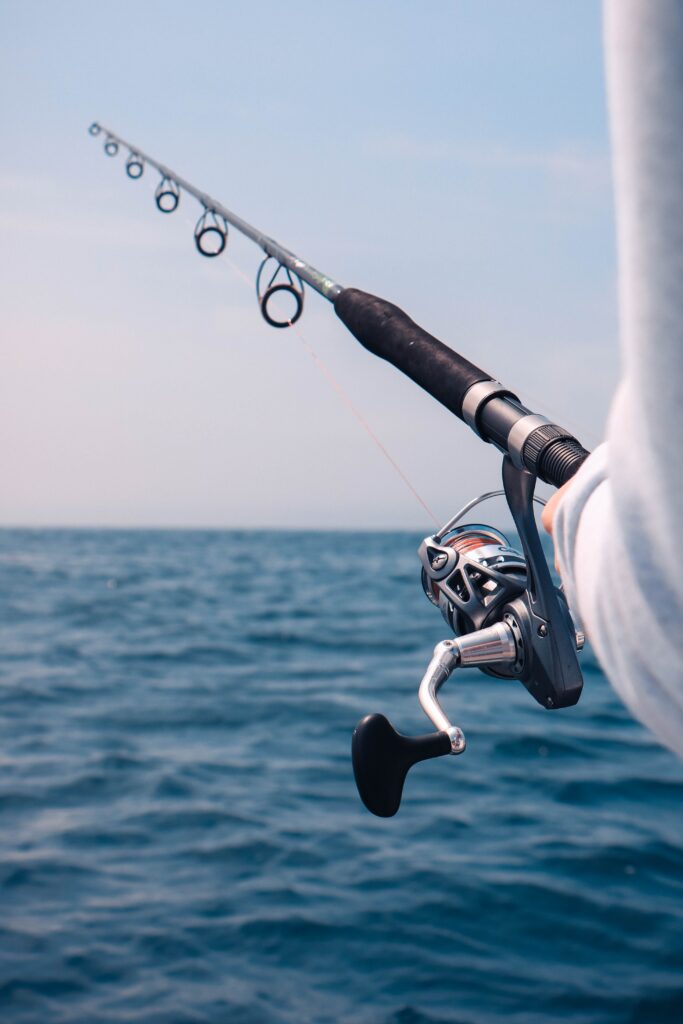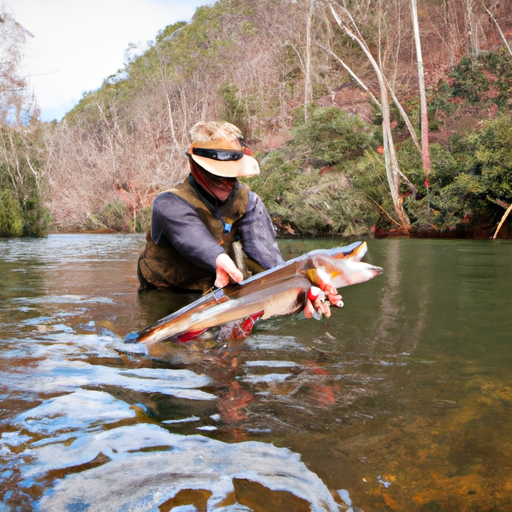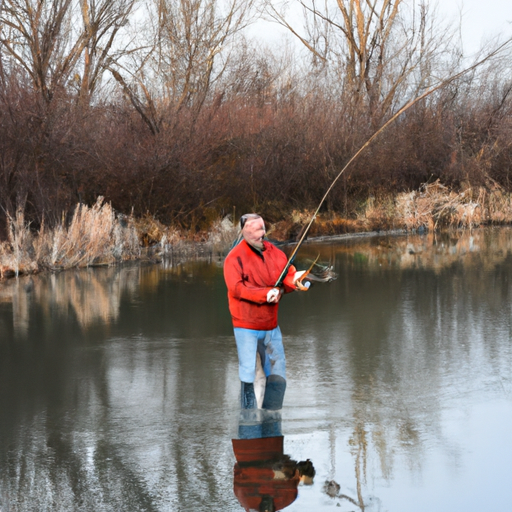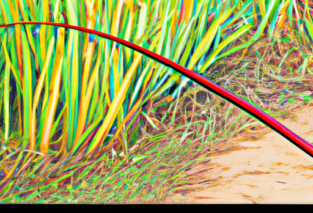March is an exciting time for fishing enthusiasts as the early spring season brings new opportunities to catch some of the most sought-after fish species. Whether you’re an experienced angler or just starting out, “Can You Go Fishing in March: Early Spring Fishing Tips and Techniques” is your ultimate guide to making the most of this time of the year. Packed with expert advice and proven strategies, this comprehensive resource will help you navigate the challenges and capitalize on the abundant fishing opportunities that March has to offer. From selecting the right gear to understanding the best techniques for different fish species, this product is your key to a successful and enjoyable fishing experience this spring.

Choosing the Right Location
Researching local fishing spots
When you’re planning a fishing trip in March, it’s important to research local fishing spots in your area. Look for lakes, rivers, or streams that are known for their fishing opportunities. Online resources, such as forums and websites dedicated to fishing, can provide valuable information about the best spots to try during early spring. Additionally, local bait and tackle shops or experienced anglers in your community may have insights on the most productive areas.
Considering water temperature
Water temperature plays a crucial role in determining the behavior and location of fish. During early spring, the water temperature may still be relatively cold, which means that fish might be more sluggish and less active. Keep in mind that different fish species have different temperature preferences, so it’s essential to consider this factor when selecting your fishing location.
Identifying potential spawning areas
Early spring is a time when many fish species start their spawning activities. Finding potential spawning areas can greatly enhance your chances of a successful fishing trip. Look for shallow areas with vegetation or structures such as fallen trees, rocks, or submerged structures, as these are often preferred spawning grounds for fish. Researching the spawning habits of the species you plan to target can further narrow down your search for the perfect fishing spot.
Selecting the Right Gear
Choosing the appropriate fishing rod
Selecting the right fishing rod is crucial for a successful fishing trip. When fishing in March, you’ll likely encounter colder water temperatures, so it’s important to choose a rod that can handle heavier baits and lures. A medium to medium-heavy rod is generally a good choice for early spring fishing, as it provides enough strength and sensitivity to detect bites while still allowing for accurate casts.
Selecting the right reel
Pairing your fishing rod with the appropriate reel is essential for optimal performance on the water. For early spring fishing, a spinning reel is often a popular choice due to its versatility and ease of use. Look for a reel size that matches your rod and is capable of holding enough fishing line for the targeted fish species.
Picking the best fishing line
Choosing the right fishing line can significantly impact your fishing success. In early spring, when the water is still cold and fish might be less active, using a fluorocarbon line can be advantageous. Fluorocarbon lines are known for their low visibility in the water and increased sensitivity, making it easier to detect subtle bites. However, keep in mind that the fishing conditions and target species may require different types of fishing lines, so it’s essential to consider these factors when making your selection.
Deciding on the bait or lures
Selecting the appropriate bait or lures is crucial for enticing fish to bite. In early spring, when fish might be less active, it’s often beneficial to use slower-moving baits or lures. Soft plastics such as worms or creature baits are popular choices, as they can be presented in a more enticing and natural manner. Additionally, using lures that mimic the preferred prey of the fish species you’re targeting can help increase your chances of success. Experimenting with different bait and lure options can also help you determine what the fish are more likely to bite on during this time of the year.

Understanding Fish Behavior
Identifying fish species
Knowing the fish species you’re targeting is essential for understanding their behavior and preferences. Different fish species have distinct characteristics and habits, so it’s important to familiarize yourself with their appearances, feeding patterns, and habits. This knowledge will help you make more informed decisions about where and how to fish.
Learning about their spawning habits
March is a crucial time for the spawning activities of many fish species. Understanding their spawning habits can provide valuable insights into their behavior and preferred locations. Some species prefer to spawn in shallow areas with vegetation, while others seek out deeper waters or structures. Researching the specific spawning behaviors of the fish species in your area can give you a better understanding of where to target your fishing efforts.
Understanding their preferred feeding patterns
Understanding the preferred feeding patterns of fish species can significantly increase your chances of catching them during early spring. Some fish may still be sluggish due to the colder water temperatures, so it’s important to adapt your fishing techniques accordingly. For example, if you’re targeting bass, consider using slow presentations or finesse techniques that mimic easy prey. Knowing the types of food sources fish are actively feeding on during this time can help you select the most effective bait or lures.
Adapting to Changing Conditions
Monitoring weather forecasts
When planning a fishing trip in March, it’s crucial to stay updated with the weather forecasts. March often brings unpredictable weather patterns, and sudden changes in weather conditions can affect fish behavior. Keep an eye on temperature fluctuations, as colder temperatures can make fish more sluggish. Additionally, be aware of any potential rain or storms, as they can influence fishing conditions and fish activity.
Being prepared for temperature fluctuations
In early spring, temperature fluctuations can occur frequently and dramatically. It’s crucial to be prepared for these changes to ensure a comfortable and successful fishing experience. Dressing in layers and having extra clothing options can help you adjust to changing temperatures throughout the day. It’s also advisable to bring gloves, hats, and other accessories to protect yourself from the elements.
Adjusting fishing techniques based on water clarity
Water clarity can vary depending on weather conditions and the location you’re fishing in. During early spring, it’s common for water clarity to be affected by rain or melting snow, resulting in murkier waters. Adjusting your fishing techniques to accommodate for reduced visibility can improve your chances of catching fish. Using lures or baits with more vibration or scent can help fish locate your offering even in murky waters.

Fishing Techniques for Early Spring
Slow presentations for sluggish fish
During early spring, fish might be less active and more sluggish due to colder water temperatures. As a result, using slow presentations can be highly effective in enticing fish to bite. Slowing down your retrieval speed and using lures or baits that mimic injured or slow-moving prey can help trigger strikes from these less active fish.
Using finesse techniques for pressured fish
In March, many anglers hit the waters after a long winter break, increasing the fishing pressure on certain areas. Pressured fish can become wary and less willing to bite, requiring finesse techniques to fool them into striking. Downsizing your baits or lures and using subtle, finesse presentations can make a significant difference in enticing these pressured fish.
Targeting pre-spawn and spawning areas
Early spring is a time when many fish species start their pre-spawn and spawning activities. By targeting these areas, you can increase your chances of catching actively feeding fish. Look for shallow areas with vegetation, submerged structures, or deeper waters adjacent to spawning grounds. This is where fish will congregate during the pre-spawn and spawn, making it an ideal spot to cast your line.
Experimenting with different retrieve speeds
March brings varying water temperatures and changing fish behaviors. Experimenting with different retrieval speeds can help you determine what attracts fish at any given time. Some fish might respond better to a slow, steady retrieve, while others might be enticed by a faster, more aggressive presentation. By trying out different retrieve speeds, you can find the perfect rhythm to entice fish to strike.
Tips for Catching Fish in March
Using scent attractants
When fish are less active in colder water temperatures, using scent attractants can make your baits or lures more appealing. Applying fish attractants or using bait products that release scent can help attract fish and trigger strikes. The added scent can compensate for the reduced visibility and entice fish to investigate your offering.
Making efficient use of limited daylight hours
In March, the daylight hours are still relatively limited. To make the most of your fishing trip, plan your fishing activities around the peak feeding times of the fish species you’re targeting. Early morning or late afternoon periods are often when fish are more active and likely to bite. Pay attention to the feeding patterns and behaviors of the fish you’re targeting to optimize your fishing efforts during these limited daylight hours.
Trying out live bait options
Live bait can be highly effective during early spring when fish might be less willing to chase after artificial lures. Baitfish such as minnows or worms can be a great choice for attracting fish in colder waters. Depending on the regulations and the fish species you’re targeting, using live bait can increase your chances of enticing strikes and landing fish.

Safety Precautions
Wearing appropriate clothing and gear
When heading out for a fishing trip in March, it’s crucial to wear appropriate clothing and gear to ensure your safety and comfort. Dressing in layers will allow you to adjust to changing temperatures throughout the day. Additionally, wearing water-resistant or waterproof clothing can protect you from potential rain or splashes while out on the water. Don’t forget to wear a hat and sunglasses to shield yourself from the sun’s rays.
Checking fishing regulations and licensing requirements
Before casting your line, it’s important to familiarize yourself with the fishing regulations and licensing requirements in your area. Each region may have different rules and regulations regarding catch limits, size restrictions, and fishing seasons. Make sure you have the proper fishing license and adhere to all local fishing regulations to ensure a legal and ethical angling experience.
Informing someone about your fishing plans
Prior to heading out for a fishing trip, it’s always a good idea to inform someone about your plans and intended fishing location. Letting a trusted friend or family member know your schedule and location can provide an added layer of safety. In case of an emergency or if you encounter unforeseen circumstances, this person will be aware of your whereabouts and can assist you if needed.
Conservation Practices
Releasing undersized or unwanted fish
Practicing responsible angling includes releasing any undersized or unwanted fish back into the water. By respecting catch limits and size restrictions, you contribute to the conservation of fish populations and ensure the sustainability of the resource. Handling fish with care and releasing them properly can increase their chances of survival, allowing them to grow and reproduce in future seasons.
Practicing catch and release techniques
Catch and release fishing is an effective conservation practice. When practicing catch and release, it’s important to handle fish carefully to minimize stress and injury. Wetting your hands before handling fish, using barbless hooks, and minimizing the time the fish spends out of the water can greatly increase its chances of survival after release. By practicing catch and release, you contribute to the long-term health of fish populations and the overall ecosystem.
Avoiding sensitive spawning areas
During early spring, many fish species are engaged in spawning activities, and it’s essential to avoid disturbing their sensitive spawning areas. These areas are critical for the successful reproduction and survival of fish populations. Be aware of signs or information indicating the presence of spawning grounds and make a conscious effort to avoid fishing or disturbing these areas. Respecting nature’s cycles and fish reproduction processes is crucial for sustainable fishing practices.

Additional Considerations
Joining local fishing communities and forums
One way to enhance your knowledge and passion for fishing is by joining local fishing communities and forums. Connecting with fellow anglers who fish in your area can provide valuable insights, tips, and tricks. These communities often share information about local fishing spots, fish behaviors, and the most effective fishing techniques. By engaging with experienced anglers, you can expand your fishing network and learn from their expertise.
Learning from experienced anglers
Learning from experienced anglers is an invaluable resource for improving your fishing skills. Whether through mentorship programs or simply striking up conversations with seasoned anglers, their knowledge and experience can help you become a more proficient angler. Ask questions, observe their techniques, and listen to their advice. By building relationships with experienced anglers, you’ll have access to a wealth of insights that can enhance your fishing success.
Keeping a fishing journal for future reference
Keeping a fishing journal can be a valuable tool for future reference and improvement. After each fishing trip, take a few moments to record important details such as the location, weather conditions, water temperature, species caught, techniques used, and the overall success of the trip. By documenting these details, you can identify patterns and trends over time, helping you make more informed decisions and increasing your chances of success on future fishing trips.
Conclusion
Fishing in March during the early spring season offers unique challenges and exciting opportunities. By choosing the right location, selecting the appropriate gear, understanding fish behavior, adapting to changing conditions, and implementing effective fishing techniques, you can greatly increase your chances of a successful fishing trip. Remember to prioritize safety, practice conservation, and continually learn from experienced anglers to enhance your fishing skills and knowledge. So, grab your gear, find the perfect fishing spot, and embrace the joys of early spring fishing!





